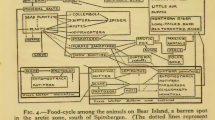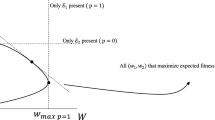Summary
Any character that has a substantial effect on a species' distribution and abundance can exert a variety of indirect effects on evolutionary processes. It is suggested that an organism's capacity for habitat selection is just such a character. Habitat selection can constrain the selective environment experienced by a population. Habitat selection can also indirectly influence the relative importance of natural selection, drift, and gene flow, through its effect on population size and growth rate. In many circumstances (but not all), habitat selection increases population size and growth rate, and thereby makes selection in a local environment more effective than drift and gene flow.
Similar content being viewed by others
References
Antonovics, J. (1968) Evolution in closely adjacent plant populations. VI. Manifold effects of gene flow.Heredity,23, 507–24.
Barton, N. H. and Charlesworth, B. (1984) Genetic revolutions, founder events, and speciation.Ann. Rev. Ecol. Syst. 15, 133–64.
Begon, M. (1977). The effective size of a natural Drosophila subobscura population.Heredity 38, 13–18.
Begon, M. and Mortimer, A. (1981)Population Ecology. Sinauer Press, Sunderland, Mass.
Bradshaw, A. D. (1983) The importance of evolutionary ideas in ecology — and vice versa. B. Shorrocks (ed.), pp. 1–25.Evolutionary Ecology. Blackwells, London.
Bush, G. L. (1975) Modes of animal speciation.Ann. Rev. Ecol. Syst. 6, 339–64.
Carson, H. L. and Templeton, A. R. (1984) Genetic revolutions in relation to speciation phenomena: the founding of new populations.Ann. Rev. Ecol. Syst. 15, 97–131.
Charnov, E. L. (1976) Optimal foraging: The marginal value theorem.Theor. Pop. Biol. 9, 129–36.
Comins, H. N. (1977) The development of insecticide resistance in the presence of migration.J. Theor. Biol. 64, 177–97.
Crow, J. F. and Kimura, M. (1970)An Introduction to Population Genetics Theory. Harper and Row, New York.
Diamond, J. M. (1984) ‘Normal’ extinctions of isolated populations. InExtinctions (M. H. Nilecki, ed.) pp. 191–246. University of Chicago Press, Chicago.
Emlen, J. M. (1984)Population Biology. Macmillan, New York.
Endler, J. A. (1977)Geographic Variation, Speciation, and Clines. Princeton Univ. Press, Princeton, N.J.
Endler, J. A. (1986)Natural Selection in the Wild. Princeton Univ. Press, Princeton, N.J.
Ewens, W. J. (1982) On the concept of effective population size.Theor. Pop. Biol. 21, 373–8.
Fisher, R. A. (1958)The Genetical Theory of Natural Selection. Dover Publications, New York.
Ford, E. B. (1974)Ecological Genetics, 4th edn. Chapman & Hall, London.
Fretwell, S. D. (1972)Populations in a Seasonal Environment. Princeton Univ. Press: Princeton, N.J.
Garcia-Dorado, A. 1986. The effect of niche preference on polymorphism protection in a heterogeneous environment.Evolution 40, 936–45.
Georghiou, G. P. and Taylor, C. E. (1977) Genetic and biological influences in the evolution of insecticide resistance.J. Econ. Entom. 70, 319–23.
Gillespie, J. H. (1983) Some properties of finite populations experiencing strong selection and weak mutation.Amer. Natur. 121, 691–708.
Ginzburg, L. R. (1983)Theory of Natural Selection and Population Growth. Benjamin-Cummings, Menlo Park, Ca.
Gould, S. J. and Lewontin, R. C. (1979) The spandrels of San Marco and the Panglossian paradigm: a critique of the adaptationist programme.Proc. Roy. Soc. London (B)205, 581–98.
Grant, V. (1980) Gene flow and the homogeneity of species populations.Biol. Zbl. 99, 157–69.
Haldane, J. B. S. (1930) A mathematical theory of natural and artificial selection. Part VI. Isolation.Proc. Camb. Phil. Soc. 26, 220–30.
Hastings, A. (1983) Can spatial variation alone lead to selection for dispersal?Theor. Pop. Biol. 24, 244–51.
Hedrick, P. W. (1986) Genetic polymorphism in heterogeneous environments: A decade later.Ann. Rev. Ecol. Syst. 17, 535–66.
Heywood, J. S. (1986) The effect of plant size variation on genetic drift in a population of annuals.Amer. Natur. 127, 851–61.
Hill, W. G. (1982) Rates of change in quantitative traits from fixation of new mutations.Proc. Natl. Acad. Sci. 79, 142–5.
Holt, R. D. (1983) Models for peripheral populations: The role of immigration. InPopulation Biology (H. I. Freedman and C. Strobeck, eds), Lecture Notes in Biomathematics, Vol. 52, pp. 25–32. Springer-Verlag, New York.
Holt, R. D. (1985) Population dynamics in two-patch environments: Some anomalous consequences of an optimal habitat distribution.Theor. Pop. Biol. 28, 181–208.
Karn, M. N. and Penrose, L. S. (1951) Birth weight and gestation time in relation to maternal age, parity, and infant survival.Annals Eugen. 16, 147–64.
Kimura, J. and Crow, J. F. (1963) The measurement of effective population numbers.Evolution 17, 279–88.
Kimura, J. and Ohta, T. (1971)Theoretical Aspects of Population Genetics. Princeton University Press: Princeton, N.J.
Lande, R. (1976) Natural selection and random genetic drift in phenotypic evolution.Evolution 30, 314–34.
Lande, R. (1979) Quantitative genetic analysis of multivariate evolution, applied to brain-body size allometry.Evolution,33, 402–16.
Leigh, E. G. (1981) The average lifetime of a population in a varying environment.J. Theor. Biol. 90, 213–39.
Levin, S., Cohen, D. and Hastings, A. (1984) Dispersal strategies in patchy environments.Theor. Pop. Biol. 26, 165–91.
Lynch, M. (1984) The selective valve of alleles underlying polygenic traits.Genetics 108, 1021–33.
May, R. M. (1976) Simple mathematical models with very complicated dynamics.Nature 261, 459–467.
May, R. M. and Dodson, A. P. (1986) Population dynamics and the rate of evolution of pesticide resistance. InPesticide Resistance: Strategies and Tactics for Management, pp. 170–93. National Academy Press, Washington, D.C.
Maynard Smith, J. (1983) The genetics of stasis and punctuation.Ann. Rev. Genet. 17, 11–25.
Mayr, E. (1954) Change of genetic environment and evolution. InEvolution as a Process (J. Huxley, A. C. Hardy and E. B. Ford, eds) pp. 157–80. Allen and Unwin, London.
Motro, U. and Thomson, G. (1982) On heterozygosity and the effective size of populations subject to size changes.Evolution 36, 1059–66.
Mueller, L. D., Wilcox, B. A., Ehrlich, P. A., Heckel, D. G. and Murphy, D. D. (1985) A direct assessment of the role of genetic drift in determining allele frequency variation in populations ofEuphydryas editha.Genetics 110, 495–511.
Nagylaki, T. 1975. Conditions for the existence of clines.Genetics 80, 595–615.
Nagylaki, T. (1977)Selection in One- and Two-Locus Systems. Springer-Verlag, New York.
Nagylaki, T. (1978) Clines with asymmetric migration.Genetics 88, 813–27.
Nagylaki, T. (1979) The island model with stochastic migration.Genetics 91, 163–76.
Nei, M., Maruyama, T. and Chakraberty, R. (1975) The bottleneck effect and genetic variability in populations.Evolution 29, 1–10.
Nei, M. and Grauer, D. (1984) Extent of protein polymorphism and the neutral mutation theory.Evol. Biol. 17, 73–118.
Newman, C. M., Cohen, J. E. and Kipnis, C. (1985) Neo-darwinian evolution implies punctuated equilibria.Nature 315, 400–1.
Ohta, R. (1972) Population size and rate of evolution.J. Mol. Evol. 1, 305–14.
Parsons, P. A. (1983)The Evolutionary Biology of Colonizing Species. Cambridge University Press, Cambridge.
Provine, W. B. (1985). The R.A. Fisher-Sewall Wright controversy and its influence upon modern evolutionary biology.Oxford Surveys in Evol. Biol. 2, 197–119.
Rosenzweig, M. L. (1974) On the evolution of habitat selection.Pr. First Internat. Cong. Ecol. pp. 401–404. Center for Agricultural Publishing and Documentation, Wageningen, Netherlands.
Rosenzweig, M. L. (1985) Some theoretical aspects of habitat selection. InHabitat Selection in Birds (M. Cody, ed.), pp. 517–540. Academic Press, New York.
Rosenzweig, M. L., Brown, S. and Vincent, T. L. (1987) Red Queens and ESS: the coevolution of evolutionary rates.Evol. Ecol. 1, 59–96.
Schaffer, W. M. and Rosenzweig, M. L. (1978) Homage to the Red Queen I. Coevolution of predators and their victims.Theor. Pop. Biol. 9, 135–157.
Slatkin, M. (1977) Gene flow and genetric drift in a species subject to frequent local extinctions.Theor. Pop. Biol. 12, 253–262.
Slatkin, M. (1985) Gene flow in natural populations.Ann. Rev. Ecol. Syst. 16, 393–430.
Slatkin, M. (1987) Gene flow and the geographic structure of natural populations.Science 236, 787–792.
Stanley, S. M. (1979)Macroevolution: Pattern and Process. W. H. Freeman, San Francisco.
Taylor, C. E. (1976) Genetic variation in heterogeneous environments.Genetics 83, 887–894.
Templeton, A. R. and Rothman, E. D. (1981) Evolution in fine-grained environments. II. Habitat selection as a homeostatic mechanism.Theor. Pop. Biol. 19, 326–340.
Travis, J. and Trexler, J. C. (1986) Interactions among factors affecting growth, development and survivorship in experimental populations ofBufo terrestris (Anura: Bofonidae).Oecologia 69, 110–116.
Via, S. and Lande, R. (1985) Genotype-environment interaction and the evolution of phenotypic plasticity.Evolution 39, 505–522.
Wallace, B. (1959) Influence of genetic systems on geographic distribution.Cold Spring Harbor Symp. Quant. Biol. 24, 193–204.
Wallace, B. (1975) Hard and soft selection revisited.Evolution 29, 465–473.
Whitham, T. G. (1980) The theory of habitat selection: Examined and extended using Pemphigus aphids.Amer. Natur. 115, 449–466.
Whittaker, R. H. (1967) Gradient analysis of vegetation.Biol. Rev. 42, 207–264.
Wright, S. (1977)Evolution and the Genetics of Populations. Vol. 3. Experimental Results and Evolutionary Deductions. University of Chicago Press, Chicago.
Wright, S. (1982) The shifting balance theory and macroevolution.Ann. Rev. Genet. 16, 1–19.
Author information
Authors and Affiliations
Rights and permissions
About this article
Cite this article
Holt, R.D. Population dynamics and evolutionary processes: the manifold roles of habitat selection. Evol Ecol 1, 331–347 (1987). https://doi.org/10.1007/BF02071557
Issue Date:
DOI: https://doi.org/10.1007/BF02071557




